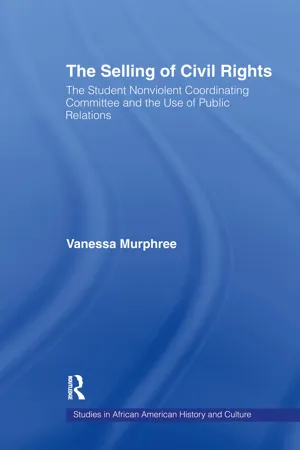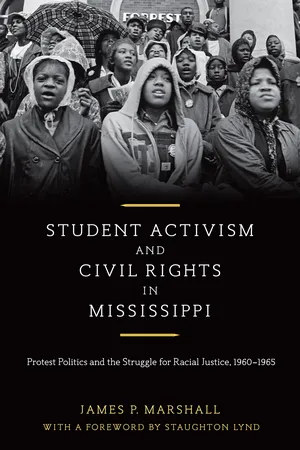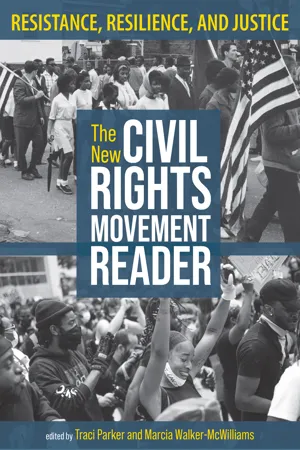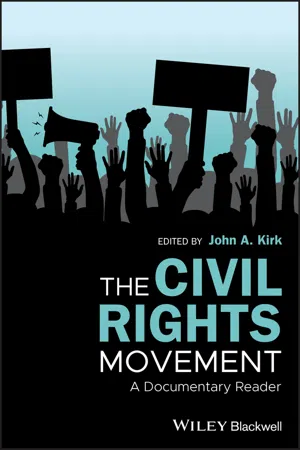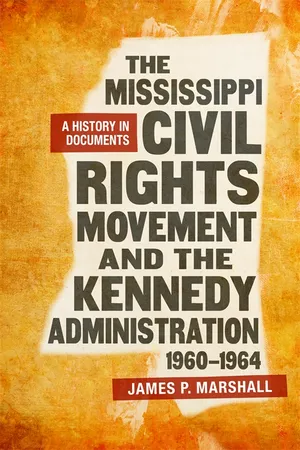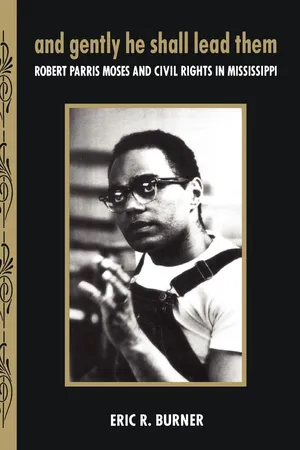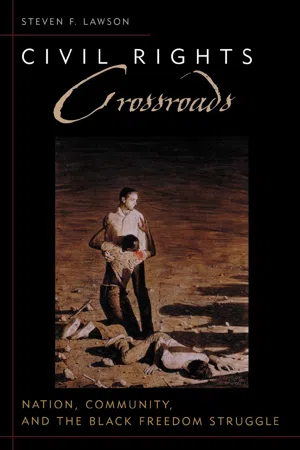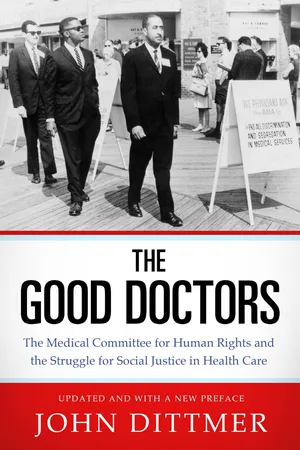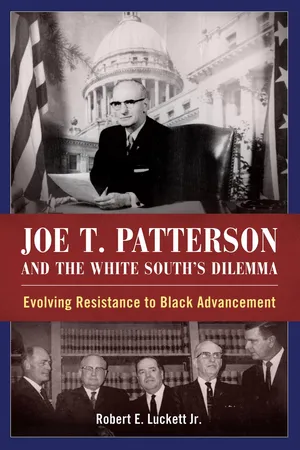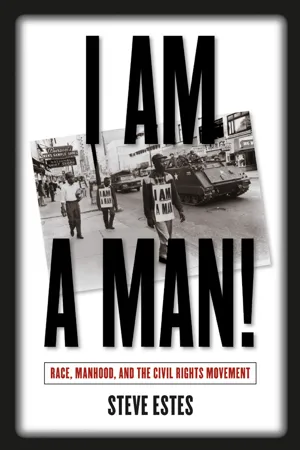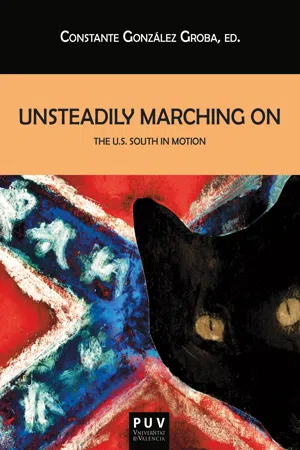History
Freedom Summer
Freedom Summer refers to a 1964 voter registration drive in Mississippi, organized by civil rights organizations to increase African American voter participation and challenge segregation. The campaign aimed to confront racial discrimination and empower African Americans to exercise their right to vote. Despite facing violent opposition, the initiative significantly contributed to the Civil Rights Movement and the eventual passage of the Voting Rights Act of 1965.
Written by Perlego with AI-assistance
Related key terms
12 Key excerpts on "Freedom Summer"
- eBook - ePub
The Selling of Civil Rights
The Student Nonviolent Coordinating Committee and the Use of Public Relations
- Vanessa Murphree(Author)
- 2013(Publication Date)
- Routledge(Publisher)
Chapter Three Freedom Summer: 1964You had to bring the country’s attention to the state, and the obvious way to do that was to bring the country’s children down there. You make Mississippi a big campaign—you nationalize Mississippi, essentially, by bringing America’s children to Mississippi. Nobody can ignore the state then.1—Charles Cobb, SNCC worker, October 1996Local newspapers called it an invasion. But SNCC organizers viewed the 1964 Freedom Summer as an opportunity. Within a three-month period they would use their public relations skills to expose Americans to the illegal and immoral activities taking place in the “sovereign state of Mississippi,” thereby gaining national support in their battle for civil rights for citizens of all colors and ethnicities. Although approximately 1,000 volunteers would indeed purposefully try to impose their beliefs upon white Mississippians during the summer of 1964, their intrusion into the state’s “closed society” would lead to an even greater imposition on the nation’s conscience—bringing into America’s living rooms images so horrific and shameful that the country felt compelled to create new laws denying southern racists their long-standing power to deny black citizens their basic rights.The Freedom Summer planners had clear intentions from the very start: to register black Mississippians for the vote, and to educate these voters on how the electoral process could work to improve their lives. As the Freedom Summer progressed, SNCC workers expanded their tried-andtested communication skills to organize communities, provide political and cultural education, and to create a political party and convention delegate selection campaign. The Freedom Summer also represented a period marked by increasingly proactive communication strategies. Although SNCC planning tended to look at relatively short time frames, it did allow for the development of new characteristics that would serve the organization well as it followed its path of continuous evolution throughout the decade. Since the organization was gaining national prominence, it was also receiving increasing amounts of cash donations, allowing SNCC leaders and volunteers to carry out more ambitious projects. For the first time, communications work was not limited to the Atlanta headquarters; as procedures became standardized, the group opened communication posts throughout Mississippi. - eBook - ePub
Student Activism and Civil Rights in Mississippi
Protest Politics and the Struggle for Racial Justice, 1960-1965
- James P. Marshall(Author)
- 2013(Publication Date)
- LSU Press(Publisher)
7Freedom Summer, Part I
They say that freedom is a constant struggle.…Oh, Lord, we’ve struggled so long.We must be free, we must be free.—A MOVEMENT SONGThe strongest preservative of the closed society is the closed mind. It has been argued that in the history of the United States democracy has produced great leaders in great crises. Sad as it may be, the opposite has been true in Mississippi. As yet there is little evidence that the closed society will ever possess the moral resources to reform itself, or the capacity for self-examination, or even the tolerance of self-examination.—JAMES W. SILVER, SPRING 1964T he Mississippi Summer Project operated on two levels. On the one hand there were programs aimed at the immediate problems within the state, and on the other there were programs that represented an attempt to dramatize those problems and win participation in the political forum for Mississippi African Americans on a national level. The first projects were voter registration activities, the Freedom Schools, community centers, research pointed at winning federal help for the African American community, and the “white folks” project. Then there was the Mississippi Freedom Democratic Party, which attempted to gain the place of the regular Mississippi Democratic Party delegation at the Democratic National Convention in August 1964 and challenged the seating of the Mississippi delegation in the U.S. House of Representatives in January 1965. All of these projects will be discussed in later chapters.At the outset, though, it is necessary to take note of the process of getting ready for the Summer Project, along with the orientation, composition, and organization of the volunteers. In addition, the “invasion” that attempted to force open the closed society was greeted by the Mississippi power structure in ways that determined the outcome of the Summer Project. - eBook - ePub
Sisters in the Struggle
African American Women in the Civil Rights-Black Power Movement
- Bettye Collier-Thomas, V.P. Franklin(Authors)
- 2001(Publication Date)
- NYU Press(Publisher)
Moreover, the significance of the freedom vote was that it paved the way for the formation of the Mississippi Freedom Democratic Party (MFDP), a year later. 7 Mississippi Freedom Summer and the MFDP By 1964, the COFO officers had conceived the idea for the Freedom Summer Project. In spite of the freedom vote a year earlier, by this time, only 6.7 percent of Mississippi’s black adults had succeeded in signing up to vote. 8 Moreover, the U.S. Supreme Court’s Brown v. Board of Education decision had mandated the desegregation of public schools ten years earlier, yet in all districts across the state, schools remained segregated, as did other public accommodations such as restaurants, theaters, motels, and recreational facilities. The Freedom Summer Project was conceived by Robert Moses and Allard Lowenstein, a white civil rights activist, with support from local activists, notably Fannie Lou Hamer and Lawrence Guyot. 9 After earlier voter registration efforts yielded meager results, Moses and the others agreed that a more intensive campaign had to be devised. According to Moses, they “decided that outside intervention alone would make possible a significant breakthrough in voter registration in Mississippi and that this intervention could come about only with greater national publicity regarding Mississippi civil rights activities.” 10 The architects of Freedom Summer recruited and brought in a massive influx of northern black and white college students to Mississippi, where they registered potential voters in an effort to dramatize conditions in the state. It was an attempt on the part of the project’s planners to force the federal government to intervene in the state. More importantly, another goal of Freedom Summer was to develop grassroots leadership which would sustain itself long after the college students had left - eBook - ePub
The New Civil Rights Movement Reader
Resistance, Resilience, and Justice
- Traci Parker, Marcia Walker-McWilliams, Traci Parker, Marcia Walker-McWilliams(Authors)
- 2023(Publication Date)
- University of Massachusetts Press(Publisher)
Mississippi subsequently became a major site for challenging voting rights violations by organizing greater numbers of African Americans to register to vote, despite fears of retaliation. Long seen as a segregationist stronghold, the state of Mississippi also produced some of the most outspoken civil rights activists, such as Medgar Evers, Fannie Lou Hamer, and Amzie Moore. Recall, Mississippi was also the state where Emmett Till was murdered and a stop and major site of protest during the Freedom Rides in 1961.A major campaign of the Mississippi movement was Freedom Summer. Freedom Summer was a massive voter registration project that relied on the leadership of local grassroots activists, volunteers from throughout the nation, the Student Nonviolent Coordinating Committee, and the Council of Federated Organization (COFO) members. Additionally, Freedom Summer established dozens of Freedom Schools and community centers throughout the state.The efforts of activists in Mississippi ensured the ratification of the Civil Rights Act of 1964. The Civil Rights Act of 1964 was one of the landmark pieces of legislation that came into fruition because of the civil rights movement. President John F. Kennedy first advocated for a civil rights bill following the March on Washington in August 1963. He would be assassinated before its passage, however. His successor, Lyndon B. Johnson, lobbied hard for its ratification. Finally, on July 2, 1964, the Civil Rights Act of 1964 was signed into law. The act banned civil rights and labor discrimination based on race, sex, color, religion, and national origin; allowed government agencies to withhold federal funds from programs permitting or practicing discrimination; established the Equal Employment Opportunities Commission to monitor employment discrimination; and gave the U.S. attorney general the power to initiate proceedings against segregated facilities and schools that refuse to obey the act.Though the Civil Rights Act of 1964 opened up opportunities for civil rights activists to challenge voting rights violations, white southerners remained resistant to Black enfranchisement. As a result, activists challenged the impact of voting rights discrimination in the lily-white Mississippi Democratic Party—arguably the most visible and hostile political sect to Black political power. Fannie Lou Hamer, Aaron Henry, Bob Moses, Ella Baker, Lawrence Guyot, Annie Devine, Victoria Gray, and others formed the Mississippi Freedom Democratic Party in the spring of 1964. The MFDP challenged the state Democratic Party for leadership and credentials at the 1964 Democratic National Convention (DNC) in New Jersey. In short, African Americans sought a seat at the political table. - eBook - ePub
The Civil Rights Movement
A Documentary Reader
- John A. Kirk, John A. Kirk(Authors)
- 2020(Publication Date)
- Wiley-Blackwell(Publisher)
Chapter 8 The Civil Rights Act of 1964, Freedom Summer, and the Mississippi Freedom Democratic Party, 19648.1 US Congress, Civil Rights Act of 1964
President Lyndon B. Johnson was well equipped to take forward the civil rights legislation that Kennedy had proposed. As a Texan, Johnson was considered a southerner, but he was also someone who was sympathetic to civil rights. An admirer of President Franklin D. Roosevelt’s New Deal liberalism, Johnson gained first‐hand experience of racial and ethnic discrimination while teaching in segregated Mexican‐American schools. Unlike the younger and fresh‐faced Kennedy, Johnson was a seasoned politician, having served as a US congressman, senator, senate majority whip, and senate Democratic leader. This gave Johnson the necessary political experience and connections to drive civil rights legislation through a normally recalcitrant Congress that was full of powerful southern politicians. The signing into law of the Civil Rights Act of 1964 on 2 July also reflected in no small measure Johnson’s political skill in casting the legislation as a tribute to a slain President Kennedy for a nation still in mourning. Of course, the legislation equally rested on the moral force of movement activists’ demands at local, state, and national levels, and the movement’s successful building of a national public consensus outside of the South in support of civil rights.The Civil Rights Act of 1964 was a very wide‐ranging piece of legislation. Title I tackled voting rights, although not nearly comprehensively enough, which led to separate and more extensive legislation the following year. Title II prohibited discrimination in public accommodations on the basis of “race, color, religion or national origin.” Title III prohibited state and local government from denying access to public facilities. Title IV paved the way for a more rigorous enforcement of school desegregation. Title V expanded the role of the Civil Rights Commission, which had been formed by the Civil Rights Act of 1957. Title VI prevented discrimination by government agencies in receipt of federal funds. Title VII tackled employment discrimination, including discrimination against women in the workplace. Title VIII required the compilation of voter registration and other voting data in certain geographical areas. Title IX made it easier to move civil rights cases from state to federal courts. Title X established a Community Relations Service to assist in community disputes involving racial discrimination. Title XI dealt with how charges against those in violation of the act were handled. - eBook - ePub
The Mississippi Civil Rights Movement and the Kennedy Administration, 1960-1964
A History in Documents
- James P. Marshall(Author)
- 2018(Publication Date)
- LSU Press(Publisher)
View Freedom on My Mind (see chapter 2, document 6 source, above, for full reference) and Freedom 50 (nine DVDs) by Veterans of the Mississippi Civil Rights Movement, Inc., 2015. See also Visser-Maessen, Robert Parris Moses, 169–75 and 180–85, concerning the debate on whether to have the Summer Project and the importance of Louis Allen’s murder in making the decision to go forward with it. See Watkins, Brother Hollis, 221–27, for the debate within COFO on whether to have large numbers of whites in the Summer Project, as well as a growing surge of Klan violence in the state. See Clayborne Carson, In Struggle: SNCC and the Black Awakening of the 1960s (Cambridge, MA, 1981), 96–129, and Bruce Watson, Freedom Summer: The Savage Season That Made Mississippi Burn and Made America a Democracy (New York, 2010). See also Marshall, Student Activism, 81–82, on whether to involve large numbers of whites in the Summer Project. Document 1 is selected sections of the COFO (Council of Federated Organizations) Handbook for Political Programs which was used to orientate the Summer Project volunteers. The handbook is composed in part of the following sections: Historical Background, SNCC Enters State, Civil Rights Act Employed, Summer Project Plans, and Voter Registration Summer Prospects. This handbook was used in 1964 and parenthetically again in North Carolina in 2013 when Jim Marshall supplied it to Bob Zellner, who used it to train young North Carolinians in voter-registration work. 1. COFO Mississippi: Handbook for Political Programs INTRODUCTION Historical Background In 1876 Rutherford B. Hayes, newly elected President of the United States, ordered the withdrawal of Federal troops from the South. That order, for all practical purposes, marked the end of Negro participation in Mississippi government. . . - eBook - ePub
And Gently He Shall Lead Them
Robert Parris Moses and Civil Rights in Mississippi
- Eric Burner(Author)
- 1994(Publication Date)
- NYU Press(Publisher)
SEVENFreedom Summer
The Freedom Vote in the fall of 1963 was one victory for Robert Moses and his co-workers. The movement needed whatever victories it could get. Registration of blacks by mid-1963 was about three percent of all voters in the state; of all eligible blacks, only six percent were registered.1 The state was intransigent, the federal presence negligible. Nationally visible figures like Martin Luther King were not at the Mississippi battlefront to lend voice and publicity. “It was clear,” Moses has remarked, “that the NAACP and SCLC and CORE, none of them were really willing to put a major drive into Mississippi.… They called for working in other parts of the South first.… And NAACP’s whole policy was work all around the state.”2 SNCC’s customary methods were not cracking Mississippi. In November 1963 VEP director Wiley Branton had cut off funds to COFO’s operation in Mississippi, announcing that the organization would continue to offer minimal support for the Greenwood office from December through March and explaining that the funds already allocated to Mississippi exceeded those given to any other state. In a letter sent jointly to Henry and Moses, he added: “Of almost equal importance to our decision is the fact that the Justice Department has failed to get any meaningful decrees from any of the voter registration suits which have been filed.… We are also very concerned about the failure of the federal government to protect the people who have sought to register and vote or who are working actively in getting others to register.”3 - eBook - ePub
Civil Rights and the Struggle for Black Equality in the Twentieth Century
Nation, Community, and the Black Freedom Struggle
- Steven F. Lawson(Author)
- 2021(Publication Date)
- The University Press of Kentucky(Publisher)
PART ONE STUDYING THE CIVIL RIGHTS MOVEMENTPassage contains an image
FREEDOM THEN, FREEDOM NOW
The Historiography ofthe Civil Rights Movement
While the United States tilted in the direction of political conservatism during the past decade, the history of the civil rights movement gained in popular appeal. Martin Luther King’s birthday became a national holiday. Hollywood fictionalized the events surrounding the Mississippi Freedom Summer, drawing millions of customers to the box office. The multipart documentary series, Eyes on the Prize, I and II , portrayed this history much more accurately and won numerous awards and wide acclaim.1 Much of this interest can be attributed to the regular cycles of nostalgia that prompt Americans to recall the historical era of their youth. In this instance, memories dredged up turbulent and unsettling times, yet they also harked back to inspirational movements when ordinary people exhibited extraordinary courage. Images of civil rights heroes and heroines making great sacrifices to transform their country and their lives contrasted sharply with the prevailing Reagan-era mentality that glorified the attainment of personal wealth and ignored community health. Returning to civil rights yesteryears made many Americans feel better about themselves and what they might accomplish once again in the future.This recent popular curiosity about the subject follows on a longer professional concern with charting the course of the civil rights struggle. Scholars who began writing about the movement in the late 1960s and 1970s focused on leaders and events of national significance. They conceived of the civil rights struggle as primarily a political movement that secured legislative and judicial triumphs. The techniques of social history, which were beginning to reconstruct the fields of women’s, labor, and African American history by illuminating the everyday lives of ordinary people, at first left the study of civil rights virtually untouched. Civil rights historians were not oblivious to these new approaches, but the most accessible evidence generally steered them in traditional directions. The documentary sources on which historians customarily drew, located in the archives of presidential administrations and leading civil rights organizations, revealed a political story that highlighted events in Washington, D.C.2 Even the oral histories contained in these depositories, which could have remedied the political and institutional bias in written sources by uncovering the activities of common people at the community level, concentrated instead on civil rights leaders who gained some measure of national prominence.3 - eBook - ePub
The Good Doctors
The Medical Committee for Human Rights and the Struggle for Social Justice in Health Care
- John Dittmer(Author)
- 2017(Publication Date)
- University Press of Mississippi(Publisher)
18The Medical Committee was but a small part of the contingent of a thousand outsiders who flocked to Mississippi in the summer of 1964 to work in existing COFO projects, which were to be the staging area for expansion into new territory. A major goal of Freedom Summer was to create a truly statewide movement. Not surprisingly, most intense activity occurred in the Delta, where SNCC had been active since the spring of 1962. The volunteers assisted the veteran activists in a variety of ways. They helped staff community centers, where games and books were available, as were arts and crafts. Some of the males did traditional voter registration work, walking the streets and dusty roads to persuade blacks to take the test to try to register to vote. This activity increasingly gave way to registering local people for the new Mississippi Freedom Democratic Party, which would challenge the state’s white segregationist delegation at the national party convention later in the summer. Most of the women volunteers (and some of the men) taught in the “freedom schools.”While the Summer Project expanded and extended existing COFO programs, the freedom schools were something new to the Mississippi movement, a creative response to the woeful education afforded blacks in the state’s public schools. The curriculum encouraged maximum student participation, and was based on the assumption that “the teacher is not to be an omnipotent, aristocratic dictator.” The key to the freedom schools was the awareness that the students brought with them valuable knowledge and experiences. The assumption was that the culture of black Mississippians was important and must be preserved. The curriculum reflected this emphasis. Children (and some adults) studied traditional subjects like reading, writing, and math, but each school devoted part of the day to black history and its relationship to the civil rights movement. Several of the medical volunteers took advantage of the freedom schools to talk with the students about health care issues.19 - eBook - ePub
Joe T. Patterson and the White South's Dilemma
Evolving Resistance to Black Advancement
- Robert E. Luckett Jr.(Author)
- 2015(Publication Date)
- University Press of Mississippi(Publisher)
CHAPTER 8Freedom SummerWHEN JOE PATTERSON WON A THIRD TERM IN OFFICE IN 1963, THE CIVIL rights movement was far from over, and long days remained for Mississippi’s attorney general. To come were the political challenges of the Mississippi Freedom Democratic Party (MFDP); Freedom Summer; the murders of Andrew Goodman, Michael Schwerner, and James Chaney; the Civil Rights Act of 1964; the Voting Rights Act of 1965; James Meredith’s March Against Fear; and countless other events. During those years, Patterson refused to renounce segregation and took tough stands against the movement. He also shaped a burgeoning brand of conservatism in the South, learned at the feet of Pat Harrison, which rejected the explicit racism that had characterized the region’s history but was predicated on the implicit subjugation of African Americans.In the 1920s and 1930s, Harrison was the “other” Mississippi senator during the days of Theodore Bilbo and James K. Vardaman, the demagogic forerunners of Ross Barnett. In fact, Harrison defeated Vardaman to win office, and as the state’s junior US senator, Bilbo refused to support Harrison when he ran for Senate majority leader, causing Harrison to lose that position by one vote. Within that context, Harrison fashioned a rhetoric and action plan that attempted to avoid issues of race in order to garner power within and support from the federal government, especially as chairman of the Senate Finance Committee during the New Deal. Joe Patterson joined Harrison’s staff as his chief legislative aide in 1936, and much of his future ideology and public career was shaped by the Mississippi senator.As Freedom Summer approached in Mississippi during 1964, Patterson stood at the forefront of a political machine that helped transition southern Democrats, who recognized the waning influence of white die-in-the-ditch resistance, into modern-day Republicans, who leaned on rhetoric meant to sustain white political hegemony without being explicitly racist. That transition was so successful that many purveyors of conservative politics believed that a supposed postracial America had dawned after the election of Barack Obama in 2008. No sign illustrated the shift in politics away from the days of Ross Barnett’s racist virulence better than Paul Johnson’s inaugural address as governor of Mississippi. - eBook - ePub
I Am a Man!
Race, Manhood, and the Civil Rights Movement
- Steve Estes(Author)
- 2006(Publication Date)
- The University of North Carolina Press(Publisher)
In the spring of 1964, SNCC leaders assessed the lessons of the campaign. The white Democratic candidate, Paul Johnson, had won, but according to SNCC organizer Ivanhoe Donaldson, this was almost beside the point. The freedom vote “showed the Negro population that politics is not just ‘white folks’ business,’” Donaldson observed, and also that “whites can work [for civil rights] in Mississippi (at least white males).” Recognizing the important contributions of volunteers, Donaldson and others in SNCC still feared that given southern taboos against “miscegenation,” the presence of white females would add a volatile ingredient to an already explosive situation in Mississippi. These and other concerns about the volunteers set the stage for a debate over the role of white students in the Mississippi summer project of 1964. 19 In the wake of the freedom vote, SNCC'S small cadre of Mississippi organizers began to plan a much larger campaign for the summer. SNCC then teamed up with the NAACP and other civil rights groups in an alliance called the Council of Federated Organizations (COFO). As the strongest proponents of the summer project, SNCC'S Bob Moses and Charlie Cobb argued that student volunteers could staff a massive voter registration campaign and teach summer classes for the state's black children, who attended substandard, segregated schools during the year. Many local organizers, however, worried that the volunteers’ educational advantages would overwhelm and intimidate local activists - eBook - ePub
- AAVV(Author)
- 2017(Publication Date)
- Publicacions de la Universitat de València(Publisher)
The symbolic field of the text connects two places with seemingly distinct histories, and on more than one temporal plane: facing northward, a chain of syntagmatic images links the archipelago to the continental US; facing southward, the metaphors that emphasise that connection are fragile, and made more tenuous by an overarching nationalism, but in the novel they emerge as metaphysical and natural: the sea, and the storms and hurricanes that unite sites of pain and loss in the Caribbean and the U.S. South. Whether another person’s point of view is listened to, or understood, is made crucial, both at the personal level of Sara and Sam’s relationship and in terms of historical common ground and political interdependence. In my reading, the novel takes the shape of a series of questions about the movement not all of which are answered. Those that are answered find their resolution in the social symbolic, notably: To what extent may the convergence of race and rights in Mississippi in 1964 act as a fulcrum for respecting a broader history forged across seemingly ex-centric and exotopic places i.e. the former plantation regions of the Caribbean as well as the U.S. South, or “Plantation America” in George Handley’s conceptualization? And: To what extent could movement activists in the South conceive of racial justice outside of local and national models in the mid-1960s?The center of the novel is the notorious abduction and murder of Schwerner, Chaney and Goodman by a posse of police and Klansmen. The murders that took place on a deserted Mississippi back road in the dark of night of June 21, 1964 are relocated in a racial continuum and the recovery of the young men’s bodies is infused with a mystical hyperreality and Africanist moral force. Schwerner and Goodman were white volunteers from New York City and Chaney was African American and local to Philadelphia, Mississippi where they were all killed. The Freedom Summer Project that brought them together was designed to “take Mississippi to the nation” (Rev. Ed King, qtd. in Marsh 29). SNCC volunteer Fannie Lou Hamer, the granddaughter of slaves and one of twenty children in a sharecropper family, described the hope behind the COFO project: “They want to make democracy a reality in the whole country—if it is not already too late” (Hamer viii-ix). The national-symbolic importance of Freedom Summer far outweighed the relatively small number of participants; some 700 student volunteers joined COFO organizers in SNCC and the Council for Racial Equality (CORE), whose efforts to forge voter registration and community projects, including Freedom Schools, were buttressed by lawyers, ministers and doctors. Other activists lost their lives in 1964 but the murders of these three young men held the front page and also led to the first successful federal prosecution of a civil rights case in 1960s Mississippi. That the murders occurred at the very beginning of the campaign cast them in a luridly notorious light; while Chaney was a seasoned agitator with CORE and Schwerner something of a veteran working full-time with his wife Rita in Mississippi, Andrew Goodman was the representative student volunteer and his abduction within two days of arriving in Mississippi hit full force.4 The search for the bodies of the slain workers was one of the biggest undertaken by the FBI, with naval officers detailed to explore rivers, swamps and forests. That search is re-imagined in Beyond the Limbo Silence
Index pages curate the most relevant extracts from our library of academic textbooks. They’ve been created using an in-house natural language model (NLM), each adding context and meaning to key research topics.
